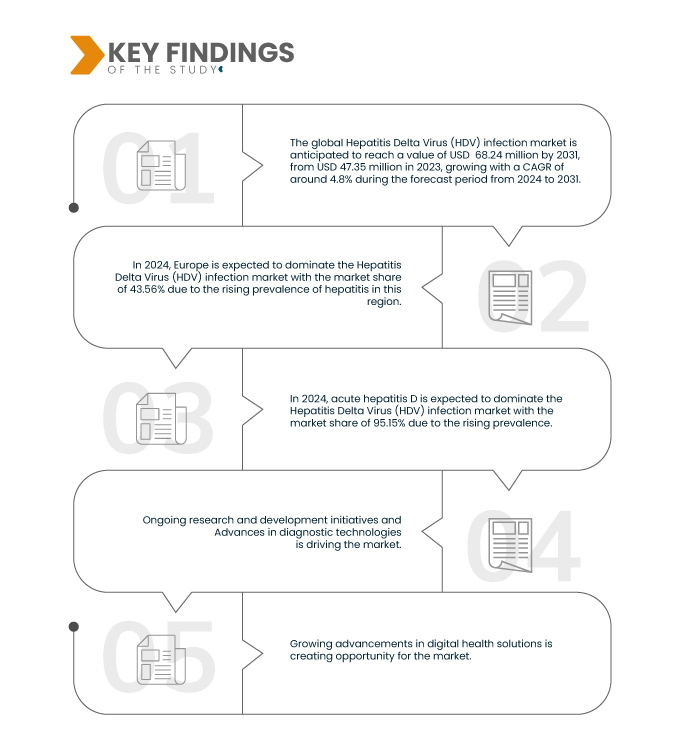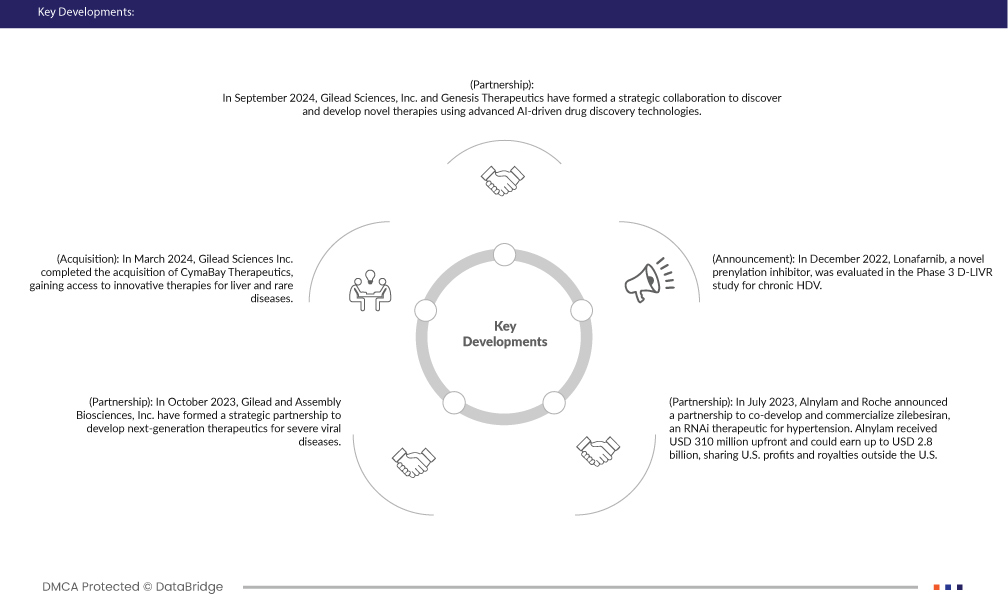The growing prevalence of hepatitis, particularly hepatitis B, is significantly influencing the global Hepatitis Delta Virus (HDV) infection market. Hepatitis D is a liver infection caused by the Hepatitis D Virus (HDV), which requires the presence of the Hepatitis B Virus (HBV) to replicate. As hepatitis B infections increase globally, the number of individuals susceptible to HDV infection also rises. This growing pool of HBV-infected individuals creates a larger target population for HDV, thus driving demand for diagnostic and therapeutic solutions specific to HDV.
According to an article published by the World Health Organization (WHO), in April 2024, it is estimated that 1.3 million people died from chronic viral hepatitis B and C in 2022 that constitutes of almost 3500 deaths per day. Moreover, it is estimated that 254 million people are living with hepatitis B and 50 million people are living with hepatitis C worldwide.
The increasing incidence of hepatitis B has heightened awareness about co-infection risks, prompting more research and development efforts focused on HDV. This rising awareness translates into more significant investment in HDV diagnostics, including more accurate and efficient testing methods, and in the development of therapeutic agents specifically targeting HDV. Pharmaceutical companies and research institutions are responding to the growing need for effective HDV treatments, contributing to market growth by introducing innovative therapies and expanding their portfolios.
Every year, on 28 July, WHO partners with other organizations to increase awareness and understanding of viral hepatitis and the diseases that it causes on World Hepatitis Day. This date honored the birthday of Nobel Laureate Professor Baruch Samuel Blumberg, discoverer of the hepatitis B virus. It provided an opportunity to step up national and international efforts on hepatitis, to encourage actions and engagement by individuals, partners and the public, and to highlight the need for a greater global response.
Moreover, the rise in HDV infections due to higher hepatitis B prevalence has led to increased healthcare expenditures related to managing co-infections. Health systems around the world are facing greater financial and logistical challenges, leading to a growing market for HDV-specific treatments and interventions. Governments and healthcare organizations are investing more in prevention, screening, and treatment programs to address the burden of HDV and related complications, further fueling the market growth.
In addition to the direct impact on healthcare systems, the growing prevalence of hepatitis B and subsequent HDV infections has spurred global collaborations and initiatives aimed at combating the disease. International health organizations and advocacy groups are working to improve surveillance, promote vaccination against hepatitis B, and enhance treatment accessibility. These global efforts not only raise awareness but also drive demand for HDV-specific medical solutions, thereby accelerating the growth of the HDV infection market.
Access Full Report @ https://www.databridgemarketresearch.com/es/reports/global-hepatitis-delta-virus-hdv-infection-market
Data Bridge Market Research analyzes that the Global Hepatitis Delta Virus (HDV) Infection Market is expected to reach USD 68.24 million by 2031 from USD 47.34 million in 2023, growing at a CAGR of 4.8% in the forecast period of 2024 to 2031.
Key Findings of the Study
Increase in Healthcare Expenditure
The increase in healthcare expenditure has a significant impact on the growth of the global Hepatitis Delta Virus (HDV) infection market by facilitating more substantial investment in diagnostic technologies and treatment options. As healthcare budgets expand, governments and healthcare organizations are able to allocate more resources towards advanced diagnostic tools for HDV. This investment leads to the development and deployment of more sensitive and accurate testing methods, which enhances early detection rates and drives up demand for diagnostic services. The improved availability of high-quality diagnostic tests contributes directly to market growth by increasing the overall testing and screening activities. Moreover, higher healthcare expenditure often translates into better access to and affordability of treatment options for HDV. As funding increases, there is greater potential for the development and distribution of innovative antiviral therapies and other medical interventions. This expanded access to effective treatments not only improves patient outcomes but also stimulates market growth by creating a more extensive patient base seeking treatment options. Enhanced therapeutic options can lead to better disease management and higher rates of treatment adherence, further boosting demand within the HDV infection market.
Report Scope and Market Segmentation
|
Report Metric
|
Details
|
|
Forecast Period
|
2024 to 2031
|
|
Base Year
|
2023
|
|
Historic Years
|
2022 (Customizable to 2016–2021)
|
|
Quantitative Units
|
Revenue in USD Million
|
|
Segments Covered
|
Type (Acute Hepatitis D and Chronic Hepatitis D), Treatment (Surgery (Liver Transplant) and Medication), Drug Type (Branded and Generic), Route of Administration (Oral and Parenteral), Age Group (Adults, Geriatric, and Pediatric), Gender (Female and Male), Transmission (Contaminated Needles, Exposure to Infected Blood, Blood and Plasma Product Transfusion, and Others), End User (Hospitals, Specialty Clinics, Home Care Setting, Research Institutes and Academic Centers, Ambulatory Surgical Centers, and Others), Distribution Channel (Direct Tender, Retail Sales, and Others)
|
|
Countries Covered
|
U.S., Canada, Mexico, Germany, France, U.K., Italy, Spain, Netherlands, Switzerland, Russia, Belgium, Turkey, Denmark, Sweden, Poland, Norway, Finland, Rest of Europe, China, Japan, India, South Korea, Australia, Thailand, Malaysia, Indonesia, Singapore, Philippines, New Zealand, Vietnam, Taiwan, Rest of Asia-Pacific, Brazil, Argentina, Rest of South America, South Africa, Saudi Arabia, U.A.E., Egypt, Bahrain, Kuwait, Oman, Qatar, and Rest of Middle East and Africa
|
|
Market Players Covered
|
Gilead Sciences, Inc. (U.S.), Genentech, Inc. (U.S.), Eiger BioPharmaceuticals (U.S.), Johnson & Johnson Services, Inc. (U.S.), Assembly Biosciences, Inc. (U.S.), PharmaEssentia Corporation (Taiwan), Vir Biotechnology, Inc. (U.S.), Huahui Health Ltd.,(China) Replicor (Canada), GlobeImmune Inc. (U.S.), and Alnylam Pharmaceuticals, Inc. (U.S.) among others.
|
|
Data Points Covered in the Report
|
In addition to the insights on market scenarios such as market value, growth rate, segmentation, geographical coverage, and major players, the market reports curated by the Data Bridge Market Research also include depth expert analysis, patient epidemiology, pipeline analysis, pricing analysis, and regulatory framework.
|
Segment Analysis
Global Hepatitis Delta Virus (HDV) Infection market is segmented into nine notable segments which are type, treatment, drug type, route of administration, age group, gender, transmission, end user, and distribution channel.
- On the basis of type, global Hepatitis Delta Virus (HDV) infection market is segmented into acute hepatitis D and chronic Hepatitis D
In 2024, acute hepatitis D segment is expected to dominate the global Hepatitis Delta Virus (HDV) infection market
In 2024, acute hepatitis D segment is expected to dominate the market with a market share of 95.15% due to its high mortality rate, rapid progression to liver failure, and limited treatment options, making it a critical area of focus for researchers and healthcare professionals.
- On the basis of treatment, global Hepatitis Delta Virus (HDV) infection market is segmented into surgery (liver transplant) and medication
In 2024, surgery (liver transplant) segment is expected to dominate the global Hepatitis Delta Virus (HDV) infection market
In 2024, the surgery (liver transplant) segment is expected to dominate the market with a market share of 63.75% due to its increasing adoption as a last-resort treatment for patients with end-stage liver disease or liver failure caused by HDV infection, which offers a chance for survival and improved quality of life.
- On the basis of drug type, global Hepatitis Delta Virus (HDV) infection market is segmented into branded and generic. In 2024, branded segment is expected to dominate the market with a market share of 65.94%.
- On the basis of route of administration, global Hepatitis Delta Virus (HDV) infection market is segmented into oral and parenteral. In 2024, oral segment is expected to dominate the market with a market share of 65.65%.
- On the basis of age group, global Hepatitis Delta Virus (HDV) Infection market is segmented into adults, geriatric and pediatric. In 2024, adults segment is expected to dominate the market with a market share of 68.16%.
- On the basis of gender, global Hepatitis Delta Virus (HDV) Infection market is segmented into female and male. In 2024, female segment is expected to dominate the market with a market share of 69.36%.
- On the basis of transmission, global Hepatitis Delta Virus (HDV) Infection market is segmented into contaminated needles, exposure to infected blood, blood and plasma product transfusion, and others. In 2024, contaminated needles segment is expected to dominate the market with a market share of 50.91%.
- On the basis of end user, global Hepatitis Delta Virus (HDV) Infection market is segmented into hospitals, specialty clinics, home care setting, research institutes and academic centers, ambulatory surgical centers, and others. In 2024, hospitals segment is expected to dominate the market with a market share of 48.66%.
- On the basis of distribution channel, global Hepatitis Delta Virus (HDV) Infection market is segmented into direct tender, retail sales and others. In 2024, direct tender segment is expected to dominate the market with a market share of 58.71%.
Major Players
Data Bridge Market Research analyzes Gilead Sciences, Inc. (U.S.), Genentech, Inc. (U.S.), Eiger BioPharmaceuticals (U.S.), Johnson & Johnson Services, Inc. (U.S.), Assembly Biosciences, Inc. (U.S.) as the major players operating in the market.
Market Development
- In September 2024, Gilead Sciences, Inc. and Genesis Therapeutics have formed a strategic collaboration to discover and develop novel therapies using advanced AI-driven drug discovery technologies. This partnership aims to accelerate the creation of innovative treatments, enhancing Gilead's pipeline and strengthening its position in the competitive biopharma industry.
- In June 2024, Assembly Biosciences, Inc. presented new data on ABI-6250, a promising hepatitis D virus entry inhibitor. This innovation demonstrates strong potential in targeting viral entry, which could enhance treatment efficacy and position the company as a leader in advancing hepatitis D therapies.
- In March 2024, Gilead Sciences Inc. completed the acquisition of CymaBay Therapeutics, gaining access to innovative therapies for liver and rare diseases. This acquisition expands Gilead’s research portfolio and strengthens its pipeline, enhancing its capacity to address unmet medical needs. The acquisition of CymaBay provides Gilead with promising new drug candidates and expertise in liver and rare diseases, boosting its research capabilities and expanding its therapeutic offerings.
- In March 2024, Gilead Sciences, Inc. and Merus have announced a collaboration to discover novel antibody-based trispecific T-cell engagers, aiming to enhance cancer immunotherapy. This partnership combines Gilead’s expertise with Merus’ innovative technology to develop advanced treatments for cancer.
- In April 2023, Huahui Health's HH-003, a novel treatment for Chronic Hepatitis D Virus (HDV) infection, has been granted Breakthrough Therapy Designation by China’s NMPA. This designation speeds up its development and review. HH-003 has shown promising early trial results and addresses a gap in current treatments for HDV.
Regional Analysis
Geographically, the countries covered in the global Hepatitis Delta Virus (HDV) infection market report are the U.S., Canada, Mexico, Germany, France, U.K., Italy, Spain, Netherlands, Switzerland, Russia, Belgium, Turkey, Denmark, Sweden, Poland, Norway, Finland, Rest of Europe, China, Japan, India, South Korea, Australia, Thailand, Malaysia, Indonesia, Singapore, Philippines, New Zealand, Vietnam, Taiwan, Rest of Asia-Pacific, Brazil, Argentina, Rest of South America, South Africa, Saudi Arabia, U.A.E., Egypt, Bahrain, Kuwait, Oman, Qatar, and Rest of Middle East and Africa.
As per Data Bridge Market Research analysis:
Europe is the dominant and fastest-growing region in the global Hepatitis Delta Virus (HDV) infection market
Europe is expected to dominate the market due to the high prevalence of HDV in countries such as Russia, Ukraine, and Eastern European nations, where it is a major public health concern and drives demand for diagnostic and treatment solutions. It is expected to grow during the forecast period due to the increasing prevalence of HDV, early approval of Bulevirtide, and strong healthcare infrastructure supporting advanced treatments.
For more detailed information about the global Hepatitis Delta Virus (HDV) Infection market report, click here – https://www.databridgemarketresearch.com/es/reports/global-hepatitis-delta-virus-hdv-infection-market














